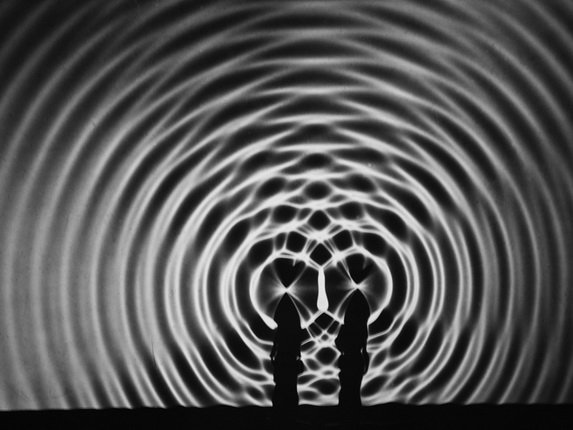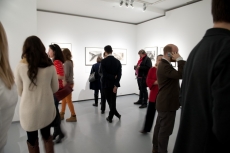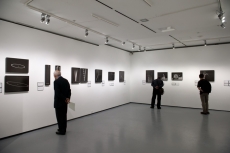Photography and Science





Berenice Abbott. Parabolic Mirror has a Thousand Eyes. 1958-61. MIT Museum Collection, Gift of Ronald A. Kurtz.
Berenice Abbott. Illusion or Reality? 1958-61. MIT Museum Collection, Gift of Ronald A. Kurtz.
Berenice Abbott. Circular Wave Systems. 1958-61. MIT Museum Collection, Gift of Ronald A. Kurtz
Berenice Abbott. Light Passes Through a Prism. 1958-61. MIT Museum Collection, Gift of Ronald A. Kurtz.
Berenice Abbott. A Bouncing Ball in Diminishing Arcs. 1958-61. MIT Museum Collection, Gift of Ronald A. Kurtz.
Moscow, 22.11.2013—19.01.2014
exhibition is over
Share with friends
Organizing curator: Gary Van Zante
Contributing curator: Julia Van Haaften
This exhibition was made possible with the generous support of Ronald A. and Carol Kurtz, and was created by the MIT Museum, Cambridge, Massachusetts for the Kurtz Gallery for Photography.
All exhibited photographs and original documents are from the MIT Museum.
For the press
This exhibition presented by the Polytechnical Museum and the Multimedia Art Museum, Moscow is the first opportunity for the Russian public to see images of scientific experiments from Bereince Abbott, this luminary of American photography.
Berenice Abbott was a relentless experimenter. Early recognition of her talent came in the 1920s in Paris, where she was acclaimed for her photo portraits. Next came her famous series featuring images of New York in the 1930s (exhibited by MAMM in 2004). Although Berenice Abbott herself regarded the science photographs balanced on a line between abstraction and the ultimate reality as her most significant professional achievement. They were continued throughout her professional career and made important contributions to the development of science photography.
Abbott recognised photography’s vast and largely unrealised potential to visualise science and communicate scientific truth to the general public. In 1939 Abbott wrote that photography must become ‘a friendly interpreter between science and the layman’. ‘There is an essential unity between photography, science’s child, and science, the parent.’
Abbott’s most important science photography came in the late 1950s. The fear that the US was lagging behind in scientific achievement, and particularly in the preparedness of young people for scientific careers, led to national high school curriculum reform initiatives that culminated in formation in 1956 of the Physical Science Study Committee (PSSC) at the Massachusetts Institute of Technology (MIT). In March 1958 the PSSC hired Abbott to prepare a large series of illustrations for the flagship PSSC project, a new high-school physics textbook. Over the next two and a half years at MIT Abbott produced some of her most accomplished photographs illustrating wave motion and other physical phenomena.
A selection of Abbott’s work for MIT was exhibited by the Smithsonian Institution as ‘The Image of Physics’, which toured the country for six years beginning in 1960 and gave thousands of Americans their first glimpse of her bold, modernist photography and the new physics pedagogy.
The focus of the MAMM exhibition is 32 original prints from the ‘The Image of Physics’ series. They are accompanied by the texts Elizabeth McCausland (art critic and Photo League activist) wrote in collaboration with scientists from the institute. This series, the centrepiece of the exhibition, is shown in the context of other works by Berenice Abbott from different years. Also on view are scrapbooks she made to document her work, as well as letters, manuscripts and various publications.
This exhibition was made possible with the generous support of Ronald A. and Carol Kurtz, and was created by the MIT Museum, Cambridge, Massachusetts for the Kurtz Gallery for Photography. All exhibited photographs and original documents are from the MIT Museum.
Berenice Abbott (1898-1991) grew up self-reliant in a troubled Ohio household. After two semesters of college she settled briefly in New York and then migrated to Paris in 1921, intending to become a sculptor. Instead, she found photographic work with the Dadaist Man Ray and in 1926 struck out on her own, achieving critical acclaim in portraiture to rival her mentor. In 1929 Abbott returned to New York. Federal Art Project support during the next decade enabled her to produce some 300 images of ‘Changing New York’, to critical acclaim. Berenice Abbott was photography editor for Science Illustrated magazine in the 1940s. The success launch of the Soviet satellite Sputnik in late 1957 helped boost the curriculum reform programme of the PSSC at MIT, which hired her as staff photographer.
From March 1958 to September 1960 Abbott collaborated with PSSC scientists on a new high-school physics textbook. In the 1960s she repurposed her PSSC photographs and created new images for three science books aimed at young readers.
Introduced to Maine in the 1950s, Berenice Abbott moved her studio there and published her last book, ‘A Portrait of Maine’, in 1968.
Today Abbott is justifiably considered one of the great masters of photography who played an important role in the history of photographic art.
Gary Van Zante is the MIT Museum’s Curator of Architecture, Design and Photography. He has curated more than 50 exhibitions ranging from Renaissance architectural graphics to contemporary design practice and photography. His photographic exhibitions at MIT have featured the work of photographers Gabrielle Basilico, Margaret Morton and Cervin Robinson, among others. He is the author of a recent study of nineteenth-century urban photography.
Julia Van Haaften was first Curator of Photographs for The New York Public Library, and subsequently Director of Collections for the Museum of the City of New York. A recognised Abbott specialist and curator in 1989 of the first major retrospective of her work, Van Haaften is currently completing a biography of the photographer.
The National Museum of the History of Science and Technology is one of the oldest and largest scientific-technical museums in the world.
The Polytechnical Museum has popularised scientific and technical information, ideas and solutions, defining the path of scientific and technical progress. It has collected and preserved mankind’s unique achievements, as shown by instruments and objects that determined the direction civilisation took at various stages in history.
In 2010 the museum began a process of modernisation — in accordance with global trends to actualise the activities of museums and cultural organisations, a broad-ranging project is now in progress to create a contemporary national and international multi-functional museum and educational centre, uniting the highest achievements of science, technology and society.
Since 2013 the historical building of the Polytechnical Museum has been closed for reconstruction. The Polytechnical Museum is operating on temporary premises or those provided by partner organisations until the completion of rebuilding work (in 2018).
The museum’s mission is to engage the wider community with MIT science, technology and other areas of scholarship in ways that will best serve the nation and the world in the 21st century. The museum has two floors filled with ongoing and changing exhibitions, currently with an emphasis on robotics, photography and holography, MIT history, and current MIT research. The museum presents monthly programmes that appeal to both middle-school and older students, and presents the annual Cambridge Science Festival in late April.
arts.mit.edu
The arts at MIT connect creative minds across disciplines and encourage a lifetime of exploration and self-discovery. They are rooted in experimentation, risk-taking and imaginative problem-solving. The arts strengthen MIT’s commitment to the aesthetic, human, and social dimensions of research and innovation. Artistic knowledge and creation exemplify our motto — mens et manus, mind and hand. The arts are essential to MIT’s mission to build a better society and meet the challenges of the 21st century.


























